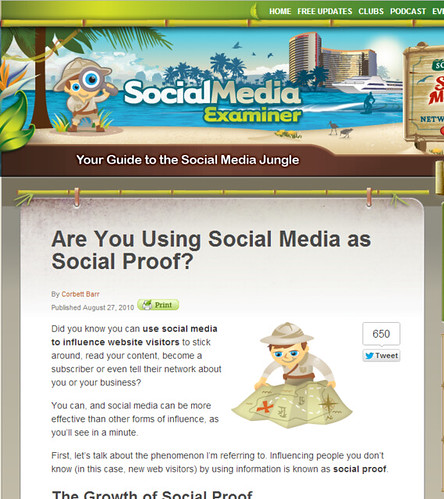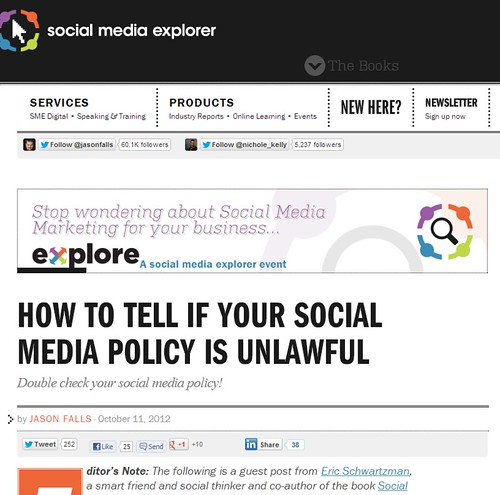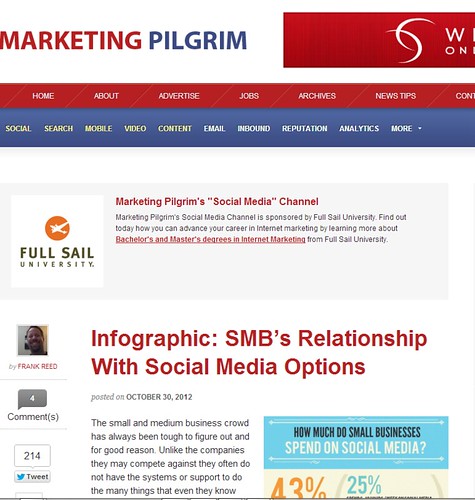 News on Social Marketing, according to Social Media Examiner: social media can influence website visitors to stick around. Influencing people you don’t know by using information is known as social proof.
News on Social Marketing, according to Social Media Examiner: social media can influence website visitors to stick around. Influencing people you don’t know by using information is known as social proof.
The Growth of Social Proof
Social proof is a psychological phenomenon which marketers use as a fundamental principle and used by blogs recently to display the number of RSS subscribers prominently (usually through FeedBurner).
Social proof provides your site an advantage over other sites that don’t use it, and helps you grow faster by turning more people into repeat visitors.
Your social media profiles and activity on Facebook, Twitter, etc., can serve as social proof too, and sometimes are even more effective than just RSS counts or traffic numbers.
How Effective Is Social Media as Social Proof?
According to Lisa Barone from Outspoken Media, social media as social proof for a blog or website is highly effective especially for an entrepreneur or small business owner. Developing a presence on the social web enhances credibility to your blog/website for it allows people to see you engaging with other people.
Creating a social media presence is another way of allowing customers to know you’ve left a light on for them. Social media actually enhances social proof.
How to Use Facebook, Twitter and Others as Social Proof
Facebook’s social widgets show how many people “like” your site or the number of people who shared your content on Facebook. Twitter can also be used in a similar way.
Get Creative With Your Site’s Social Proof
If a blog attracts lots of comments, displaying your comment counts prominently can serve as an effective form of social proof.
Read more at Are You Using Social Media as Social Proof?
 News on Social Marketing, according to Social Media Explorer: U.S. Federal Agency has been quietly neutering the social media polices of huge companies with deep pockets in the past 10 months.
News on Social Marketing, according to Social Media Explorer: U.S. Federal Agency has been quietly neutering the social media polices of huge companies with deep pockets in the past 10 months.
Social media policy is significant to social media marketers and while everyone’s involvement in social media outreach makes it easier to scale engagement, getting everyone involved without some kind of rules in place is risky.
In nearly three-quarters of the cases brought to the National Labor Relations Board, the agency that protects worker’s rights, the Board found 17 out of 23 policies governing the use of social media by employees to be unlawful.
Based on the published NLRB guidance and decisions so far, here are three things to be conscious of when you draft a social media policy:
1. Confidentiality – Social media is used to communicate, organize and build consensus by sharing with peers. Payroll information could be considered “confidential” but recently the Board found that prohibiting employees from sharing wage information infringed on their protected rights to bargain collectively.
2. Disparaging Remarks – The NLRB protects an employee’s right to call out and publicize what they see as unfair workplace practices. Employer policies having a chilling effect on protected activities are considered unlawful.
3. Media Relations – Mainstream media relations policies requiring employees to secure approval before speaking with the press also violates worker’s rights, since it could deter them from leveraging the news media to publicize unfair practices in an effort to improve their working conditions.
Social media is a communications channel owned by the customer. And since employees have the legal right to band together to improve their working conditions, avoid imposing onerous restrictions.
Read more at HOW TO TELL IF YOUR SOCIAL MEDIA POLICY IS UNLAWFUL
 News on Social Marketing, according to Marketing Pilgrim: a group of small and medium business has always been difficult to figure out and for good reason. Frequently, they do not get any systems or support for the many things they believe to better improve their business compared to the companies they may compete against.
News on Social Marketing, according to Marketing Pilgrim: a group of small and medium business has always been difficult to figure out and for good reason. Frequently, they do not get any systems or support for the many things they believe to better improve their business compared to the companies they may compete against.
Social media should be given particular concern. While many SMBs who ‘get’ social media are doing a great job of leveraging the channel for their business, on the other hand, there are others who just thought the opposite. What seems to be a common thread, however, are the types of social media that the SMB find most comfortable with.
An infographic from VerticalResponse that was shared by VentureBeat (with a hat tip to Mark) demonstrates just where SMB’s are putting their social media eggs and it seems to be in the Twitter and Facebook basket with Google+ and LinkedIn being set aside.
“Why ignore Google+ when it is a widely held position that Google+ participation has some impact on search results?” This question is likely to be asked by many SEOs.
Read more at Infographic: SMB’s Relationship With Social Media Options
Other Social Marketing Articles of Interest
Case study: Doubling sales through social media
5 Ways to Enhance Your Facebook Timeline Page With Images
